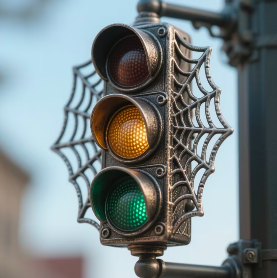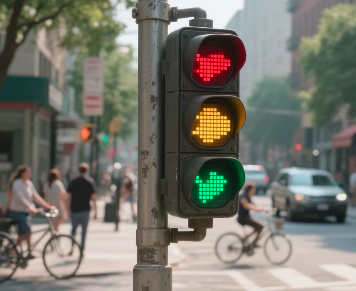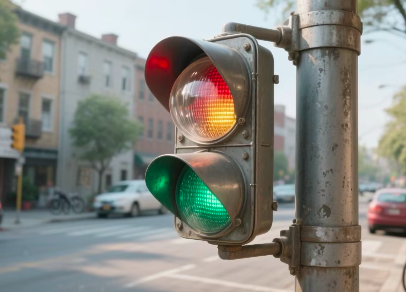Table of Contents
ToggleMini traffic lights are specialized signaling devices designed for compact urban spaces, temporary road management, or intersections with limited installation areas. A mini traffic light serves the same basic purpose as a conventional signal: it controls the flow of vehicles and pedestrians, but with a smaller footprint and a more adaptable design. These systems are increasingly used in modern cities where urban density continues to grow and road networks become more complex.
Types of Mini Traffic Lights and Their Applications
(1) Spider Web Lens Mini Traffic Lights
A unique lens structure with radial patterns similar to a web. This design allows the light to be distributed evenly across a wide angle while minimizing glare for pedestrians and drivers.

Key Features:
- Wide-angle light distribution for better side-view visibility
- Reduced glare effect under low-light or foggy conditions
- Suitable for compact intersections and pedestrian zones
(2) Mini Traffic Lights Pixel Cluster
The pixel cluster type consists of multiple individual LED pixels grouped together to form a signaling unit. Each pixel operates independently, allowing continued function even if one or two pixels fail. These mini traffic lights are widely used in temporary road setups, small-scale urban projects, or construction sites, where medium-distance visibility of around 10–30 meters is sufficient.

Key Features:
- LED cluster design with 30–60 pixels per module
- Enhanced brightness for competitive light environments
- Flexible modular structure for easy replacement
(3) Transparent Lens Mini Traffic Light Module
Transparent lens mini traffic lights utilize a clear lens that concentrates light into a more focused beam. Unlike spider web lenses, this type provides a narrower angle but a longer effective distance, making it suitable for tunnels, warehouses, or controlled traffic corridors. These lights typically operate at 12–24 V DC, making them compatible with low-voltage infrastructures.

Key Features:
- Focused light projection with minimal diffusion
- Ideal for tunnel crossings and warehouse intersections
- Long-range visibility for targeted traffic flow
Mini Traffic Lights in Urban Infrastructure
Mini traffic lights are often employed in places where standard traffic signals are not practical due to space, cost, or temporary needs. For example, in roadwork zones, they help manage alternating traffic flow in lanes as narrow as 3 meters wide. In smart city initiatives, mini traffic lights may be integrated with sensors or pedestrian buttons to improve traffic efficiency.
Energy Efficiency and Routine Maintenance
- Operational Data
Modern mini traffic lights are designed to consume minimal energy while maintaining adequate brightness. A typical mini LED module operates between 5–15 watts, providing sufficient illumination with a service life of more than 50,000 hours. This efficiency reduces operational costs for municipalities and enhances sustainability goals in urban development.
- Routine Maintenance
Regular inspection is recommended every 6–12 months to check light intensity, lens clarity, and power stability. Pixel cluster modules have an advantage in this regard since individual LED segments can be replaced without dismantling the entire unit.
Benefits of Using Mini Traffic Lights in Cities
- Space-saving design suitable for dense city layouts
- Lower power consumption compared to conventional traffic signals
- Enhanced flexibility for both permanent and temporary setups
- Reduced visual clutter in pedestrian-heavy zones
Comparison Between Mini Traffic Lights and Conventional Traffic Signals
- Enhanced Energy Efficiency
Mini traffic lights consume significantly less power than conventional traffic signals, often operating under 15 watts compared to 30–60 watts for standard lights. This reduced energy usage not only lowers operational costs but also contributes to environmentally friendly urban infrastructure.
- Flexible Installation and Adaptability
Unlike traditional traffic lights that may require days of installation or modification, mini traffic lights can be installed or relocated within hours. This flexibility makes them ideal for areas with frequent roadwork, temporary pedestrian pathways, or adaptive traffic management systems.
- Optimal Use in Urban Environments
The shorter visibility range of mini traffic lights, typically 10–40 meters, aligns with the needs of dense urban settings. Their compact size and ease of relocation allow city planners to implement dynamic traffic control solutions that improve safety and traffic flow without extensive infrastructure changes.
Future Development of Mini Traffic Lights
The evolution of mini traffic lights is closely linked with smart transportation systems. Future modules may include wireless connectivity, solar-powered operation, or adaptive brightness control based on ambient light conditions. For example, a mini traffic light in a low-traffic pedestrian alley may operate at 50% brightness during off-peak hours, reducing energy consumption while maintaining safety.
Conclusion
Mini traffic lights, including spider web lens designs, pixel cluster types, and transparent lens modules, represent a critical element of modern urban traffic management. Their adaptability, energy efficiency, and modular design make them suitable for a wide range of city environments—from roadworks and pedestrian crossings to tunnel intersections and warehouse passages. As urban areas continue to evolve, the use of mini traffic lights is expected to expand, contributing to safer and more efficient transportation systems.
0
